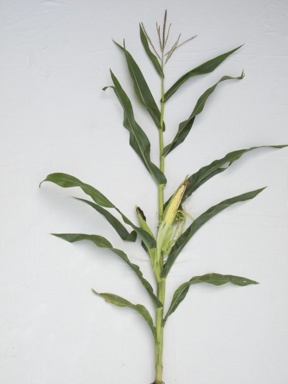Maize biology

Each maize plant is monoecious: that is, it has separate female and male parts.
The ear, or cob, is the female part of the plant; the silks near the top of the ear are really elongated stigmas, each growing from an egg on the cob.
The tassel at the top of the plant are the male part of the plant that produce the pollen. The tiny pollen grains are carried by wind to the silks, either of the same plant or a different plant, where they travel down inside the silk to fertilize an egg, which will become a kernel. In maize, the kernels are seeds, each containing a single embryo. These are the parts you would plant to grow new maize plants.
The kernels (there can be around 400 - 1000 on each ear) are attached to a cob and enclosed by layers of leaves. In the early part of the season, the whole cob could be eaten in its entirety (as with baby corn) but later in the season the kernels become harder and are best eaten cooked. Without human intervention (harvesting and cooking!), the cob would eventually fall to the ground and a new maize plant would sprout from each kernel. However, since the types of maize we currently eat have been selected to have large kernels and a big cob, the kernels would fall in a heap and not have room to grow into a healthy plant (see section on What is domestication?). When farmers grow maize, they plant kernels in rows, leaving enough space for each kernel to develop into a large, healthy plant. Maize can only grow with human help, since it has been modified from its ancestral form by domestication.
Resources:
Maize Educational Resources: http://www.maizegdb.org/education.php
The Interactive Maize plant http://www.maizegdb.org/IMP/frames_imp2.html


